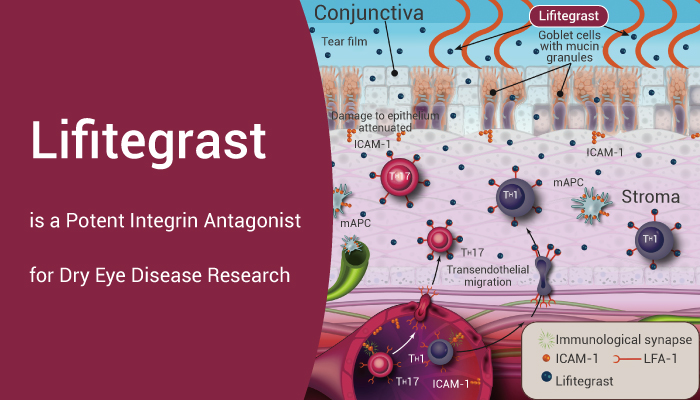Integrins are a superfamily of cell adhesion receptors that can bind to extracellular matrix ligands, cell surface ligands, and soluble ligands. Importantly, Integrins are heterodimeric transmembrane cell adhesion molecules arranged in pairs with many dimers α and β subbase composition. Particularly, Integrins regulate cell growth, proliferation, migration, signal transduction, and cytokine activation and release.
O However, Integrins, as extracellular matrix (ECM) cytoskeleton connectors and sensors for biochemical and mechanical signals between cells and their environment, play multiple roles. Under pathological conditions, abnormally activated integrins promote cell infiltration into tissues, leading to inflammation or tumor progression. Therefore, integrins have become promising targets for developing treatments for autoimmune and cancer diseases. Lifitegrast is a potent integrin antagonist for researching dry eye disease.

Lifitegrast is a Potent Integrin Antagonist for Dry Eye Disease Research.
Firstly, Lifitegrast (SAR 1118) blocks the binding of intercellular adhesion molecule 1 (ICAM-1) to lymphocyte function-associated antigen 1 (LFA-1), interrupting the T cell-mediated inflammatory cycle. Besides, Lifitegrast inhibits Jurkat T cell attachment to ICAM-1 with an IC50 of 2.98 nM. Moreover, Lifitegrast is used for researching dry eye disease.
Secondly, Lifitegrast has potent anti-inflammatory activity on corneal inflammation induced by antibiotic-killed P. aeruginosa and S. aureus in the presence of a silicone hydrogel lens. Furthermore, Lifitegrast ophthalmic drops administered thrice daily deliver therapeutic levels of Lifitegrast in the retina and can alleviate the retinal complications associated with diabetes.
Finally, Lifitegrast is a potent integrin antagonist for researching dry eye disease.
References:
[1] Perez VL, et al. Ocul Surf. 2016 Apr;14(2):207-15.